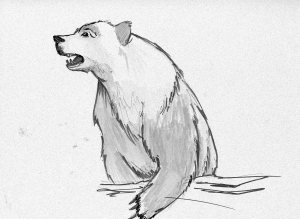 By Claude Chavis
By Claude Chavis
Over the centuries, Native Americans learned to survive comfortably in a wide range of environments, from the tropics to the Artic Circle. The necessities of life can be easily gathered in most areas of the American. Survival depends on basic skills that can be taught even to young children.
The necessities include water, food, shelter, and clothing. A fire can help us survive in many ways; to boil water to make it safe to drink, to cook food, to warm a shelter, to dry clothing, to provide light and emotional comfort, to signal for help, to smoke meat or fish for long term storage, to help tan hides for clothing and moccasins. All of these jobs are made easier by a fire.
The traditional methods of making fire include the use of flint and steel, the use of a magnifying lens (burning glass), or the use of friction. Part 3 told the story of Three Arrows; a young Mohawk brave who learned to make fire by rubbing two dry sticks together. The rubbing produces friction that produces enough heat to start tinder smoldering. Most people have used friction to warm their hands by rubbing them together on a cold day. Making fire by friction is similar to that warming.
Over the years, Native Americans have developed several variations on the friction method of making fire, most of which are require a lot of work before you see the first puff of smoke from your tinder. The Bow Drill and the Fire Saw are the two most reliable methods of starting a fire by friction. In an emergency, you can make a bow drill or fire saw without any elaborate tools. Some sticks and a rock picked up off the ground can do the trick.
The Bow Drill consists of a fireboard made from a soft wood (such as Pine), a drill made from a hard wood (such as Oak), a bow made from a piece of “springy” wood (such as Hickory or any “green” wood} and a lace (such as a work boot lace or strip of leather), and a hand piece made from either a smooth, dimpled rock or a piece of hard wood.
You will also need tinder (very fine kindling). Any dry plant materials will work: old rope, the inner bark of most dead trees, grasses, weeds, and reeds such as cattail heads, yucca, etc. Tow (the fibers from the flax plant) and raw cotton are also excellent forms of tinder. Tease the rope, tow or cotton strands into fibers. Pound bark into fibers. Rub grasses and weeds into fibers. The finer the tinder the better, you want it in strands, like hair.
Place you tinder partially under a V-notch in your fireboard. Wrap the lace around the drill one turn. Place the sharp end of the drill in the hand block and the dull end into the fire block. Begin to work the bow back and forth, like a sawing motion. Slowly increase your speed while keeping a steady rhythm. Watch for smoke coming from the fire block.
Continue “sawing” until the smoke is constant (not just an occasional puff). Quickly set the bow and drill aside and dump the hot “sawdust” from the block into your tinder. Gently blow. If no glow is seen, repeat the above steps. It may take several tries to get the “sawdust” hot enough to catch the tinder on fire.
With a little practice, you should be able to start your campfire in a minute or less. And, the best part is there are no matches to get wet or lighters to run out of fluid.
The Fire Saw is a last resort method; it consists of rubbing two pieces of wood vigorously against each other. Either a soft wood such as balsam or split bamboo make a good fire saw. To use bamboo, you want a piece of dry bamboo that is 2 to 3 inches in diameter and 2 to 3 feet long. You can normally find bamboo in swampy areas of both Carolinas. Split the bamboo in half and then cut a notch on each edge of one piece so that the notches line up. Place some tinder between the notches, and brace the notched bamboo on the ground with your foot or knee. With the other piece of split bamboo, saw in the notches until the tinder starts to smoke heavily, then blow on the tinder to ignite the fire.
Rather than just read this article, you might want to try these techniques yourself. Better yet, once you can make fire by these methods, teach someone else. Pass on the story of Blazing Arrow and the techniques to your children or grandchildren. They may need the knowledge at some time in their life and it will help preserve a part of our Native American Traditions.


